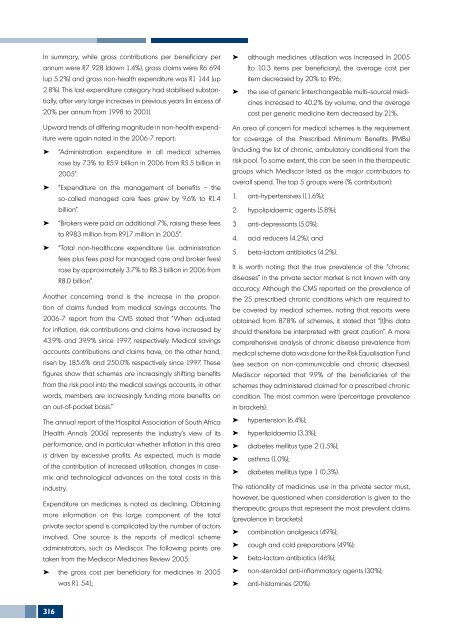SAHR 2007 - Health Systems Trust
SAHR 2007 - Health Systems Trust
SAHR 2007 - Health Systems Trust
You also want an ePaper? Increase the reach of your titles
YUMPU automatically turns print PDFs into web optimized ePapers that Google loves.
In summary, while gross contributions per beneficiary per<br />
annum were R7 928 (down 1.4%), gross claims were R6 694<br />
(up 5.2%) and gross non-health expenditure was R1 144 (up<br />
2.8%). This last expenditure category had stabilised substantially,<br />
after very large increases in previous years (in excess of<br />
20% per annum from 1998 to 2001).<br />
Upward trends of differing magnitude in non-health expenditure<br />
were again noted in the 2006-7 report:<br />
➤ “Administration expenditure in all medical schemes<br />
rose by 7.3% to R5.9 billion in 2006 from R5.5 billion in<br />
2005”.<br />
➤ “Expenditure on the management of benefits – the<br />
so-called managed care fees grew by 9.6% to R1.4<br />
billion”.<br />
➤ “Brokers were paid an additional 7%, raising these fees<br />
to R983 million from R917 million in 2005”.<br />
➤ “Total non-healthcare expenditure (i.e. administration<br />
fees plus fees paid for managed care and broker fees)<br />
rose by approximately 3.7% to R8.3 billion in 2006 from<br />
R8.0 billion”.<br />
Another concerning trend is the increase in the proportion<br />
of claims funded from medical savings accounts. The<br />
2006-7 report from the CMS stated that “When adjusted<br />
for inflation, risk contributions and claims have increased by<br />
43.9% and 39.9% since 1997, respectively. Medical savings<br />
accounts contributions and claims have, on the other hand,<br />
risen by 185.6% and 250.0% respectively since 1997. These<br />
figures show that schemes are increasingly shifting benefits<br />
from the risk pool into the medical savings accounts, in other<br />
words, members are increasingly funding more benefits on<br />
an out-of-pocket basis.”<br />
The annual report of the Hospital Association of South Africa<br />
[<strong>Health</strong> Annals 2006] represents the industry’s view of its<br />
performance, and in particular whether inflation in this area<br />
is driven by excessive profits. As expected, much is made<br />
of the contribution of increased utilisation, changes in casemix<br />
and technological advances on the total costs in this<br />
industry.<br />
Expenditure on medicines is noted as declining. Obtaining<br />
more information on this large component of the total<br />
private sector spend is complicated by the number of actors<br />
involved. One source is the reports of medical scheme<br />
administrators, such as Mediscor. The following points are<br />
taken from the Mediscor Medicines Review 2005:<br />
➤ the gross cost per beneficiary for medicines in 2005<br />
was R1 541;<br />
➤ although medicines utilisation was increased in 2005<br />
(to 10.3 items per beneficiary), the average cost per<br />
item decreased by 20% to R96;<br />
➤ the use of generic (interchangeable multi—source) medicines<br />
increased to 40.2% by volume, and the average<br />
cost per generic medicine item decreased by 21%.<br />
An area of concern for medical schemes is the requirement<br />
for coverage of the Prescribed Minimum Benefits (PMBs)<br />
(including the list of chronic, ambulatory conditions) from the<br />
risk pool. To some extent, this can be seen in the therapeutic<br />
groups which Mediscor listed as the major contributors to<br />
overall spend. The top 5 groups were (% contribution):<br />
1. anti-hypertensives (11.6%);<br />
2. hypolipidaemic agents (5.8%);<br />
3. anti-depressants (5.0%);<br />
4. acid reducers (4.2%); and<br />
5. beta-lactam antibiotics (4.2%).<br />
It is worth noting that the true prevalence of the “chronic<br />
diseases” in the private sector market is not known with any<br />
accuracy. Although the CMS reported on the prevalence of<br />
the 25 prescribed chronic conditions which are required to<br />
be covered by medical schemes, noting that reports were<br />
obtained from 87.8% of schemes, it stated that “[t]his data<br />
should therefore be interpreted with great caution”. A more<br />
comprehensive analysis of chronic disease prevalence from<br />
medical scheme data was done for the Risk Equalisation Fund<br />
(see section on non-communicable and chronic diseases).<br />
Mediscor reported that 9.9% of the beneficiaries of the<br />
schemes they administered claimed for a prescribed chronic<br />
condition. The most common were (percentage prevalence<br />
in brackets):<br />
➤ hypertension (6.4%);<br />
➤ hyperlipidaemia (3.3%);<br />
➤ diabetes mellitus type 2 (1.5%);<br />
➤ asthma (1.0%);<br />
➤ diabetes mellitus type 1 (0.3%).<br />
The rationality of medicines use in the private sector must,<br />
however, be questioned when consideration is given to the<br />
therapeutic groups that represent the most prevalent claims<br />
(prevalence in brackets):<br />
➤ combination analgesics (49%);<br />
➤ cough and cold preparations (49%);<br />
➤ beta-lactam antibiotics (46%);<br />
➤ non-steroidal anti-inflammatory agents (30%);<br />
➤ anti-histamines (20%).<br />
316
















